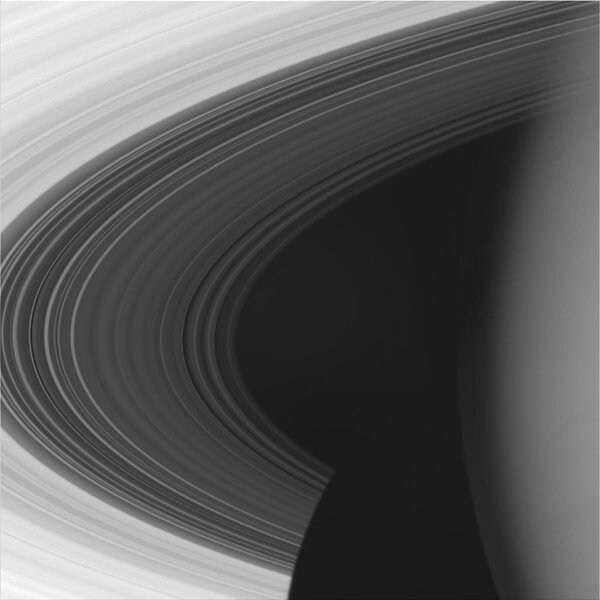Create a free profile to get unlimited access to exclusive videos, sweepstakes, and more!
How long is a day on Saturn?

As I recently wrote, Saturn is a weird place. It’s huge but the least dense of all the planets. It has a fleet of moons ranging from the simply odd to the truly bizarre. And, of course, it has that huge ring system.
Given that Saturn is visible to the naked eye, easily observable with even a small telescope, and studied by hundred of astronomers for centuries, including with spacecraft that have gone there, you’d think we’d have a pretty good idea about all its basics by now. Its mass, size, and so on.
For the most part, we do. But, embarrassingly, one property has been maddeningly hard to find: Its rotation rate.
Simply put: How long is a day on Saturn?
For something like Earth that’s not too hard to do. Our planet has a solid surface, so you can simply stand in one spot and see how long, for example, it takes a star to circle once in the sky (you can use the Sun, but Earth’s orbit complicates things there).
Saturn, though, presents a problem: There’s no surface. It has an atmosphere thousands of kilometers thick, and we only see the cloud tops. Those might have features in them like storms or spots, but these are not exactly anchored to anything solid. They move with respect to the atmosphere, making them impossible to use to see how long it takes Saturn to spin.
Another way is to use a planet’s magnetic field, generated deep inside the planet. The magnetic field lines act a little bit like a net, sweeping up particles in space as the planet spins. This generates radio waves, which can be detected by spacecraft. If the magnetic field is tipped with respect to the planet’s rotation axis, then you get a pulsing to those radio waves, and the period of the pulses then represents the time it takes the planet to spin. That’s been done for all four of the outer giant planets.
But Saturn throws a monkey in the wrench there too: Its magnetic field is only tipped from its rotation axis by 0.01°! That’s a very small amount, so the pulses are hard to measure. It’s been done twice, once with the Voyager spacecraft in the 1970s, and again with Cassini more recently. But the numbers they got were different by 6 minutes! That’s a lot when the day on Saturn is a little over 10 hours long.
However, astronomers using Cassini data have come up with a clever way to figure out Saturn’s day. They looked at the rings.
Well, kinda. The idea here is that Saturn is not just a blob of gas sitting there spinning. It has layers, and internal motions. Layers deep inside move up and down, or north and south, in a periodic fashion. As they do, they very subtly modify the gravity field of Saturn, causing it to change periodically as well.
Normally that would be impossible to detect… except Saturn has those magnificent rings, made of gazillions of tiny bits of frozen water ice. Close in to Saturn, in its C ring, those icy particles orbit at just the right rate to be affected by the oscillations deep inside Saturn (we call this matchup a resonance). This gives the particles a little bit of extra energy, like kicking your legs when you’re on a swing. The effect of this is that the particles move out of their usual orbit one after another, creating a spiral wave pattern in the rings. In this way, the ring particles act like sensitive seismometers, measuring changes inside the planet below!
Waves like these have been seen, usually created by resonance with the moons. But there have been some seen by Cassini in the C ring that didn’t line up right with any moons… but they do with the predicted oscillations inside Saturn. Using models of Saturn combined with these observations, the scientists were able to get a fairly precise measurement of Saturn’s rotation.
They found that Saturn spins once every 10 hours, 33 minutes, and 38 seconds (±1m52s/1m19s) — several minutes faster than both the Voyager measurements and the Cassini ones based on Saturn’s magnetic field. It’s not clear why.
Still, this measurement represents the bulk motion of Saturn’s spin, the time it takes the bulk of the planet to rotate once, something that wasn’t known before to such high accuracy. This number can now be used in other equations to model the interior of the giant planet, honing in on other details with better confidence.
I have no qualms in showing my amazement in this work! These are very subtle effects caused by very complicated motions of gas inside Saturn where we cannot see them directly, but can be modeled with very complex mathematics. This is some fiercely high-level stuff.
And the scientists aren’t done yet! I’ll note the title of the paper is “Cassini Ring Seismology as a Probe of Saturn’s Interior. I. Rigid Rotation”. They made some simplifying assumptions in their work, mainly that Saturn rotates as a single, rigid body. That’s not the case in reality, and future papers by this team will include the more complex nature of the way Saturn rotates, with different layers moving at different rates. That may very well focus in even better on the planet’s spin.
This is something I wouldn’t have expected in this way, that Cassini would help us understand not just the details of Saturn, its moons, and rings, but also some of the most fundamental properties of it as well.
It’s incredible, the depth and breadth of information Cassini returned to us back on Earth. Even better is how clever people can use that information, too, learning so much about this most beautiful planet in the solar system. Including, at the end of the day, when exactly is the end of the day.




























